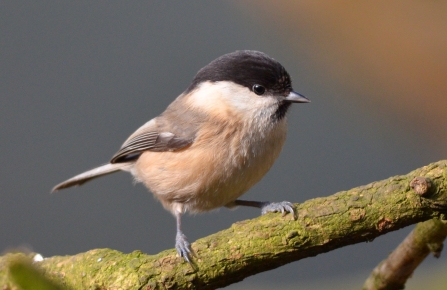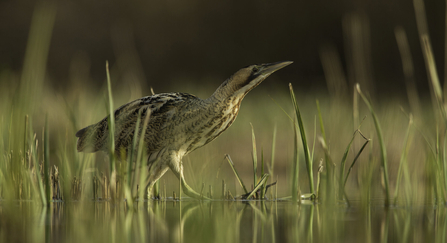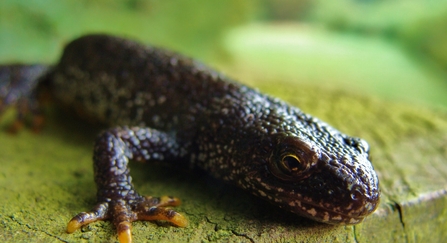- A vast new National Nature Reserve (NNR), spanning parts of Wigan and Leigh has formally been created today.
- Historic expanse of former coal mines has been reclaimed by nature and is now recognised for its national importance.
- The new NNR will protect 738.21 hectares of precious wetland habitats, home to nationally significant wildlife populations including the willow tit, water voles and the great crested newt.
Wigan Flashes - credit Lancashire Wildlife Trust
An historic expanse of former coal mines in Wigan and Leigh has today been recognised for its importance for nature and the local community.
The newly named ‘Flashes of Wigan and Leigh’ has been formally declared a National Nature Reserve (NNR) by Natural England bringing Wigan Council, Lancashire Wildlife Trust and Forestry England together to protect 738.21 hectares of wetlands.
The wetlands were originally formed through the flooding of land which had subsided due to significant coal mining during the 1800-1900s.
The flooding created a cluster of shallow open water and wetland habitats (swamp, reedbed, tall herb fen, wet marshy grassland and wet woodland) which support a rich diversity of birds and other species. This includes over 50 pairs of willow tits, around 2% of England’s total population, as well as the bittern, a secretive heron like bird, wintering duck, geese and swans. The reedbeds are also home to water voles and great crested newts.

Willow tit by Adam Jones
Jo Kennedy, Living Landscapes Development Manager from Lancashire Wildlife Trusts said:
"The declaration of The Flashes of Wigan and Leigh as a National Nature Reserve is an opportunity to celebrate, protect and enhance this area where nature has taken back places once dominated by coalfields.
"It is now a vitally important part of the North West’s Nature Recovery Network and is a home for breeding and wintering wetlands birds. It also holds two per cent of the national population of willow tit, the UK’s most endangered small bird.
"Our team was at the Flashes only last week and saw willow tit and a rare bittern, that was circling the site looking for a winter base. It truly is an important and most beautiful site just minutes from the busy streets of urban Wigan and Leigh."

Bittern by Jamie Hall
National Nature Reserves (NNRs) were established to protect some of England’s most important habitats, species and geology, provide ‘outdoor laboratories’ for research and offer opportunities to the public, schools and specialist interest groups to experience wildlife first-hand along with learning more about nature conservation.
The Flashes of Wigan and Leigh will knit together a total of thirteen sites including Wigan Flashes, Amberswood, Three Sisters, Bickershaw Country Park, Pennington Flash and Viridor Wood near Bamfurlong in Wigan.
Viridor is a relatively young woodland, planted by Forestry England just over 20 years ago, having previously been home to local industry but which now features a range of habitats includes grasslands, wetlands and lakes for the local community to enjoy.
Ginny Hinton, Area Director of Natural England, said:
“The creation of this National Nature Reserve close to so many people is an important moment for nature recovery, not only in Wigan, Leigh and the Northwest but for England. This is not least because it presents a practical demonstration of what can be done by working in partnership across the landscape at scale to reverse nature’s decline.
“Seventy years from the creation of our first National Nature Reserves in England, these wonderful places are needed now more than ever as we face into the challenges of global warming, wildlife decline and reconnecting people with the natural world.”
Councillor David Molyneux MBE. Leader of Wigan Council, said:
“We’re delighted and incredibly proud that the significance and splendour of the Flashes of Wigan and Leigh has been recognised with their declaration as a National Nature Reserve.
“Like so many of our residents, we as a council are deeply passionate about the conservation of wildlife and about providing opportunities for local people to get closer to nature and explore the beauty of their surroundings.
“Today’s announcement provides us with a wonderful platform from which to educate and inspire future generations and tell the incredible story of this unique landscape, which has been forged by our rich industrial heritage and is so important to our brighter, greener future.”
Paddy Harrop, Forest Management Director from Forestry England said:
“It’s great that Forestry England’s Viridor Wood can play a part in the Wigan and Leigh Flashes National Nature Reserve because we know that working with partners at a larger landscape scale will bring about so many benefits, not only for local communities but also for the wildlife that flourishes in the habitats found in this area”.
Wildflower meadow at Wigan Flashes - credit Lancashire Wildlife Trust
Drew Bennellick, Head of Land and Nature Policy at The National Lottery Heritage Fund, said:
“Back in 2016 we funded the Carbon Landscape project of which the Flashes of Wigan and Leigh are a key component. We’re delighted that work on this project has allowed local communities to reconnect with a landscape rich in natural, industrial and cultural history, and that this is now being recognised with the area being designated as a National Nature Reserve.
“At The National Lottery Heritage Fund, we’re incredibly proud to be playing a role in ensuring our natural heritage is safeguarded for generations to come, but also that the projects we fund give people the chance to connect with the habitats and wildlife that is on their doorsteps. The Carbon Landscape, and the Flashes of Wigan and Leigh, is a fantastic example of that, and we’re thrilled to have been able to play a part in this designation.”

Great crested newt by Kevin Caster
The announcement today demonstrates how the Government is delivering on the Environment Act – a key target which is to halt the decline in our wildlife populations through a legally binding target for species abundance by 2030.
The local tourism industry and residents are also set to benefit from this declaration, which will give more people with access to nature by making it easier for residents of local towns such as Wigan and Leigh to access the sites, as well as improving the health and wellbeing of the local community and providing economic benefits through developing wildlife tourism opportunities.
The declaration today is at the centre of celebrations for the 70th anniversary of the creation of England’s first nature reserve on 19 May 1952. Today there are 219 sites, spanning 101,531ha. These ‘nature hotspots’ are key to restoring nature across England and helping to bring green space and wildlife to everyone, including those who live in towns and cities.
There has been a ‘Festival of Nature Reserves’ this summer to celebrate with a programme of events at nature reserves. To find out more about the festival and how to get involved in remaining events across the country, visit http://www.nnrfestival.com/
